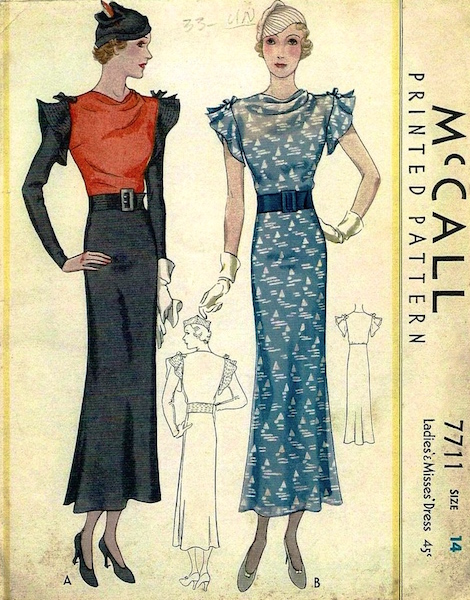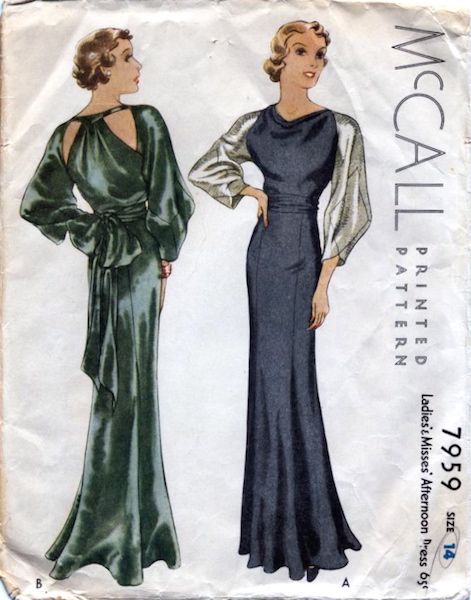
Lanvin celebrated its 125th anniversary this year. Founded in 1889 by Jeanne Lanvin, the house marked the occasion with an extensive look into its archives on Instagram, Pinterest, Facebook, and the new Lanvin Heritage website. (See WWD’s article here.) In 2015, Paris’ Palais Galliera will host a major exhibition devoted to Jeanne Lanvin.

Commercial sewing patterns based on Lanvin originals were produced between the 1920s and the 1970s. Four head designers presided over the house during that period; I’ll be devoting a post to each designer.
The interwar Lanvin designs available as sewing patterns are by Jeanne Lanvin (1867-1946), who was known for her romantic, youthful dresses with couture embellishment, particularly her robe de style, a full-skirted alternative to the 1920s tubular silhouette.

1920s
From McCall’s earliest couture patterns, this robe de style with a big bow at the waist and skirt with beaded appliqués was modelled by film star Hope Hampton:

A version of this dress is in the collection of The Costume Institute:

McCall 4856 is a short evening or afternoon dress with sheer overlay. The version on the right is in Lanvin blue:

(McCall’s also sold transfer patterns for beading and embroidery; the catalogue illustrations show nos. 1558 and 1388.)
This simple double-breasted coat from Pictorial Review was adapted from a Lanvin design:

Pictorial Review’s catalogue illustration shows the coat with contrast lapels and fur cuffs and collar:

Trim is an important feature of this Lanvin day dress, which is shown in my 1929 Paris Pattern leaflet (available in PDF from my Etsy shop):

1930s
McCall 7711 is a day dress with drape-necked bodice and bow-trimmed sleeves. View A, with long sleeves and contrast bodice, has topstitched sleeves and belt that are characteristic of 1930s Lanvin:

Here’s the illustration from McCall’s Advanced Paris Styles catalogue:

In late 1934, McCall and Pictorial Review both produced versions of the same Lanvin afternoon dress: a slim, full-sleeved gown with back cutouts. A reproduction of the McCall version is available from Past Patterns:

In Blanche Rothschild’s illustration for McCall’s magazine, the dress is shown with McCall 7954 by Georgette Renal:

The text for McCall 7959 reads, “Lanvin’s long skirted afternoon dress has a new feeling of formality. The back of the bodice is suspended in folds from a cross shoulder band, slit in triangles to expose the back. Raglan sleeves provide material contrast. The skirt spreads, bell shape, into a hesitation hem.”
The Vintage Pattern Lending Library has a reproduction of the Pictorial Review adaptation of the dress, Pictorial Review 7363:

Here’s an illustration of the Pictorial Review adaptation from the Winter 1934 catalogue:

McCall 8591 (previously featured in my goddess gowns post) is a glamourous evening dress with pleated shoulder draperies. This illustration is from the McCall catalogue:

Marian Blynn illustrated McCall 8591 for McCall’s magazine (the other gown is by Ardanse):

The caption reads: “Long scarfs, drifting down from the shoulders, are used by Lanvin. The scarf dress here is hers, and when you dance it is supposed to make you look as though you were floating. These scarfs are also worn wound once around the arm.”
Just for fun, here are two photos by Horst P. Horst and Albert Harlingue showing Lanvin designs from the 1930s:


Next in the series: Marie-Blanche de Polignac’s early Vogue Paris Originals.
Happy New Year, everyone!














